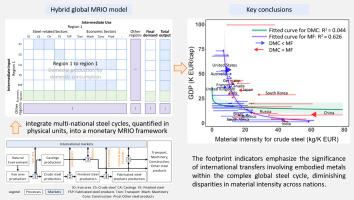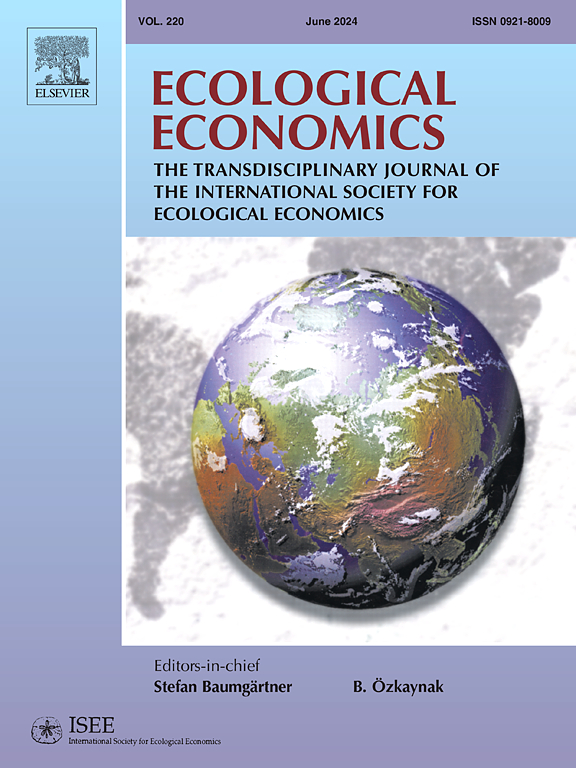混合多级钢足迹法揭示了全球经济更加相互依存的物质基础
IF 6.6
2区 经济学
Q1 ECOLOGY
引用次数: 0
摘要
钢铁是现代社会的基础,但由于全球贸易网络错综复杂,跟踪其社会经济新陈代谢具有挑战性。传统的指标,如国内材料消耗(DMC)和基于消耗的材料足迹(MF),通常只关注金属矿石的开采,忽略了钢铁生产和消费的多个阶段。为解决这一问题,我们将多国人为钢铁循环和含钢产品的国际贸易网络整合到全球货币多地区投入产出(MRIO)模型中。我们根据铁矿石、粗钢、铸件、成品钢和加工钢产品的足迹构建了材料效率指标,并将其与国内材料产量(DMP)和国内生产成本(DMC)等传统的全经济范围材料流动指标进行了比较。我们的研究结果表明,人均多阶段 MF 指标与人均 GDP 的对数线性关系更为稳健,平均 R2 值为 0.72,而 DMP 和 DMC 的 R2 值分别为 0.10 和 0.18。体现贸易在全球生产总量中的份额平均比直接贸易高出 24 个百分点,这强调了国际体现金属转移的重要性。使用多阶段 MF 指标还缩小了发达国家和发展中国家在材料效率方面的差距。这项研究揭示了错综复杂的全球钢铁供应链,以及各国含钢产品之间真正的相互依存关系。本文章由计算机程序翻译,如有差异,请以英文原文为准。

Hybrid multi-stage steel footprinting unveils a more interdependent material foundation of the global economy
Steel is foundational to modern society, yet tracking its socio-economic metabolism is challenging due to the complex global trade networks. Traditional indicators, such as domestic material consumption (DMC) and consumption-based material footprints (MF), typically focus on metal ore extraction, overlooking the multiple stages of steel production and consumption. To address this, we integrate multi-national anthropogenic steel cycles and international trade networks of steel-containing products into a global monetary multi-regional input-output (MRIO) model. We construct material efficiency indicators based on footprints of iron ores, crude steel, castings, finished steel, and fabricated steel products, comparing them with conventional economy-wide material flow indicators like domestic material production (DMP) and DMC. Our findings reveal that per capita multi-stage MF indicators exhibit more robust log-linear relationships with per capita GDP with an average R2 value of 0.72 compared to 0.10 and 0.18 for DMP and DMC. Shares of Embodied trade in total global production exceed direct trade by 24 percentage points on average, emphasizing the significance of international embodied metal transfers. Using multi-stage MF indicators also reduces disparities in material efficiency between developed and developing countries. This study unravels the intricacies of global steel supply chains and the true interdependencies of steel-containing products among countries.
求助全文
通过发布文献求助,成功后即可免费获取论文全文。
去求助
来源期刊

Ecological Economics
环境科学-环境科学
CiteScore
12.00
自引率
5.70%
发文量
313
审稿时长
6 months
期刊介绍:
Ecological Economics is concerned with extending and integrating the understanding of the interfaces and interplay between "nature''s household" (ecosystems) and "humanity''s household" (the economy). Ecological economics is an interdisciplinary field defined by a set of concrete problems or challenges related to governing economic activity in a way that promotes human well-being, sustainability, and justice. The journal thus emphasizes critical work that draws on and integrates elements of ecological science, economics, and the analysis of values, behaviors, cultural practices, institutional structures, and societal dynamics. The journal is transdisciplinary in spirit and methodologically open, drawing on the insights offered by a variety of intellectual traditions, and appealing to a diverse readership.
Specific research areas covered include: valuation of natural resources, sustainable agriculture and development, ecologically integrated technology, integrated ecologic-economic modelling at scales from local to regional to global, implications of thermodynamics for economics and ecology, renewable resource management and conservation, critical assessments of the basic assumptions underlying current economic and ecological paradigms and the implications of alternative assumptions, economic and ecological consequences of genetically engineered organisms, and gene pool inventory and management, alternative principles for valuing natural wealth, integrating natural resources and environmental services into national income and wealth accounts, methods of implementing efficient environmental policies, case studies of economic-ecologic conflict or harmony, etc. New issues in this area are rapidly emerging and will find a ready forum in Ecological Economics.
 求助内容:
求助内容: 应助结果提醒方式:
应助结果提醒方式:


